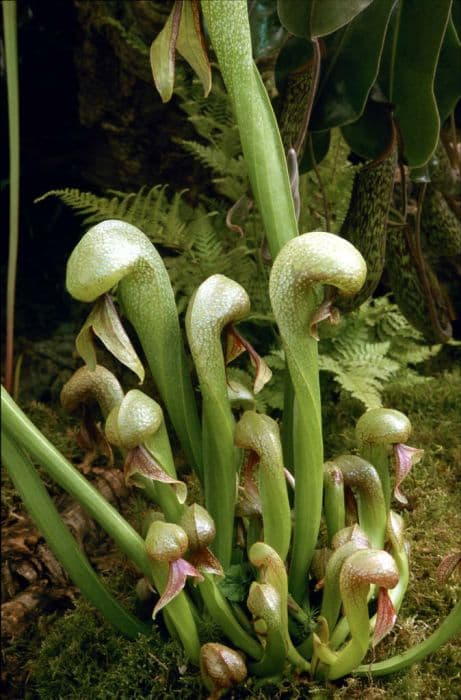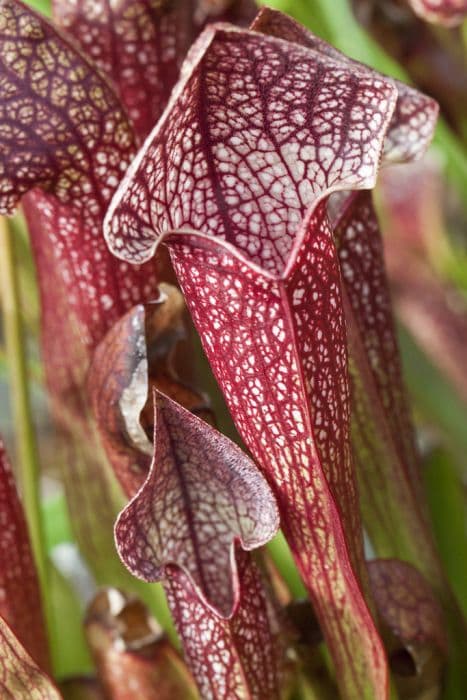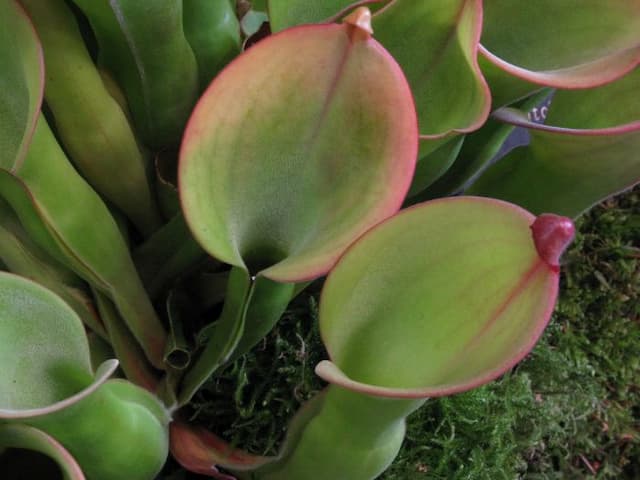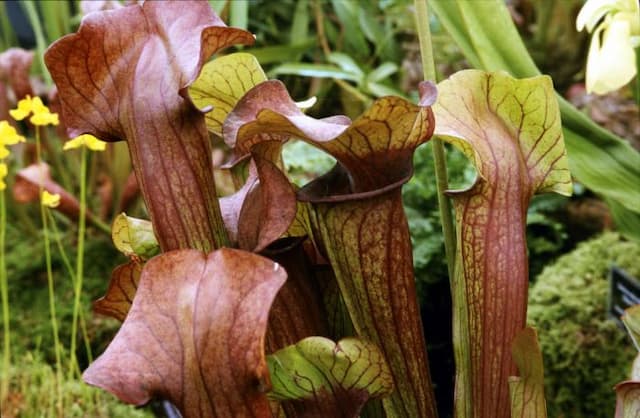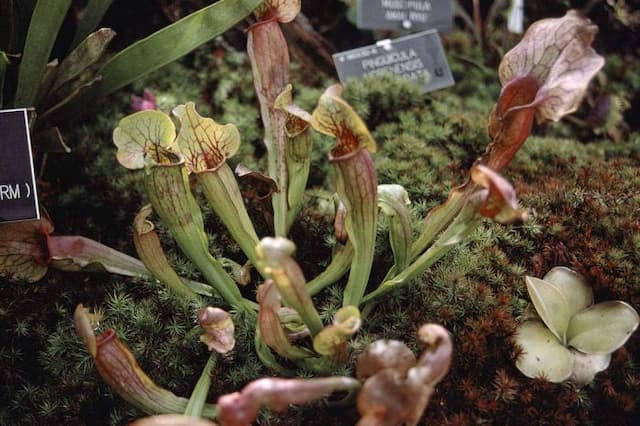Mitchell's Pitcher Plant Sarracenia × mitchelliana

ABOUT
Sarracenia × mitchelliana, commonly known as the pitcher plant, has a distinctive appearance characterized by its tubular leaves that are evolved into intricate pitchers. These pitcher-shaped leaves are primarily designed to attract and trap insects. They usually have a combination of attractive colors ranging from deep reds to vibrant greens, with patterns that often include attractive veining or speckling that serves to lure prey into the trap. The leaves are coated with a waxy substance and may have downward-facing hairs that help prevent the escape of captured insects. The top of the pitcher is flared into a hood-like structure that overhangs the opening, protecting the inside of the pitcher from excess rainwater while still allowing insects to enter. This hood is often brighter in color and can have translucent areas known as fenestrations, which confuse prey and lure them deeper into the pitcher where they cannot escape. In addition to its carnivorous leaves, the pitcher plant produces flowers that are held above the foliage on tall stalks. The flowers can be quite showy and may have a sweet scent to attract pollinators. They are typically umbrella-like in shape with multiple petals surrounding a central, prominent style. The overall appearance of the pitcher plant is both striking and functional, a testament to the unique adaptations it has developed to thrive in nutrient-poor environments by supplementing its diet with insects and other small creatures.
About this plant
 Names
NamesFamily
Sarraceniaceae
Synonyms
Mitchell's Pitcher Plant, Hybrid Pitcher Plant
Common names
Sarracenia × mitchelliana.
 Toxicity
ToxicityTo humans
The Sarracenia × mitchelliana, commonly known as the pitcher plant hybrid, does not have a known toxicity to humans if touched or ingested. These plants are carnivorous, trapping and digesting insects, but they are not considered toxic to people. As with any plant, some individuals may experience an allergic reaction or irritation if they have specific sensitivities, but there are no widespread reports of poisoning from consuming this plant. Nevertheless, it is always prudent to avoid ingesting any part of ornamental plants as a general safety precaution.
To pets
The pitcher plant hybrid, which is the common name for Sarracenia × mitchelliana, is not recognized as a toxic plant to pets either. It is a carnivorous plant meant to catch and digest insects, not harm animals. However, similarly to humans, certain pets may have individual reactions or allergies to non-toxic plants. Therefore, it is advisable to prevent pets from ingesting the plant as a safety measure, but there are no specific symptoms of poisoning associated with this plant in pets. If a pet does ingest part of the plant and shows any signs of distress, it is always best to consult a veterinarian.
 Characteristics
CharacteristicsLife cycle
Perennials
Foliage type
Evergreen
Color of leaves
Green
Flower color
Varies
Height
1-3 feet (30-91 cm)
Spread
1-2 feet (30-60 cm)
Plant type
Herb
Hardiness zones
6
Native area
Southeastern United States
Benefits
 General Benefits
General Benefits- Ecosystem role: As a carnivorous plant, Sarracenia × mitchelliana (Mitchell's Pitcher Plant) helps to control insect populations, contributing to ecological balance.
- Ornamental value: With its unique pitcher-like leaves and striking flowers, Mitchell's Pitcher Plant is an attractive addition to gardens and home collections.
- Habitat enrichment: This hybrid can provide vital microhabitats for various small organisms and contribute to the biodiversity of the area where it grows.
- Education and research: Serving as a subject for scientific study, Mitchell's Pitcher Plant aids in educating people about plant biology, hybridization, and adaptations.
- Conservation indicator: As a hybrid of species that may be vulnerable or endangered, such plants can act as indicators of environmental health and ecosystem changes.
 Medical Properties
Medical PropertiesThis plant is not used for medical purposes.
 Air-purifying Qualities
Air-purifying QualitiesThis plant is not specifically known for air purifying qualities.
 Other Uses
Other Uses- Sarracenia × mitchelliana, commonly known as pitcher plant, can be used in educational settings to demonstrate evolutionary adaptations as the plant has evolved to trap insects for nutrients.
- The pitcher plant's unique appearance can be a source of inspiration for artists and designers, with its interesting shapes and colors influencing creative works.
- Insect control is an indirect use of pitcher plants; they can naturally reduce the population of unwanted insects in a garden by trapping them.
- These plants can be featured in thematic gardens that replicate bog environments or other natural habitats, providing ecological education and conservational awareness.
- Pitcher plant, with its striking appearance, can be sold as a novelty ornamental plant for collectors and enthusiasts who specialize in cultivating carnivorous plants.
- Photographers can utilize pitcher plants as intriguing subjects, especially macro photographers interested in capturing the details of their unique trap structures.
- Due to its adaptive mechanisms, the pitcher plant may be studied in biomimicry to develop new materials or surfaces that mimic its insect-trapping abilities.
- The pitcher plant can be used as a talking point in discussions or exhibits on plant diversity and the wide range of feeding strategies among plants.
- Its exotic appearance can make the pitcher plant a unique gift for individuals interested in horticulture or unusual plants, promoting an interest in botany.
- The structure of pitcher plants can also be studied in the field of fluid dynamics, as scientists can learn how the plant manipulates fluid flows to trap insects effectively.
Interesting Facts
 Feng Shui
Feng ShuiThe Pitcher Plant is not used in Feng Shui practice.
 Zodiac Sign Compitability
Zodiac Sign CompitabilityThe Pitcher Plant is not used in astrology practice.
 Plant Symbolism
Plant Symbolism- Mystery: The Sarracenia × mitchelliana, also known as the Pitcher Plant, is symbolized by mystery due to its unique shape and carnivorous nature, which intrigues and mystifies many people.
- Attraction and Captivation: As a carnivorous plant, the Pitcher Plant attracts insects with its nectar and then captivates them, symbolizing the ability to attract and hold attention.
- Adaptation: The Pitcher Plant’s ability to thrive in nutrient-poor environments where it has adapted to derive nutrients from insects is symbolic of adaptability and survival.
- Uniqueness: The distinctiveness of the Pitcher Plant, with its specialized leaves that form pitcher-like structures, can symbolize individuality and standing out from the crowd.
 Water
WaterThe Sarracenia × mitchelliana, commonly known as the Pitcher Plant, should be watered thoroughly, ensuring that the soil is consistently moist but not waterlogged. It prefers to sit in about an inch of standing water during the growing season. Water the Pitcher Plant with distilled, rainwater or reverse osmosis water to mimic its natural boggy habitat. Water approximately every 2 to 3 days, replenishing the water as it evaporates, which might be around 1 to 2 gallons every week, depending on the environmental conditions and the size of the plant.
 Light
LightThe Pitcher Plant thrives in full sunlight, receiving direct sun for the majority of the day. The ideal location would be a south-facing window or outdoors in a place where it can get at least 6 to 8 hours of direct sunlight daily. This plant's health and ability to capture insects are directly related to the amount of sunlight it receives.
 Temperature
TemperaturePitcher Plants prefer temperatures between 70°F and 90°F during the growing season and can survive winter temperatures down to around 20°F for their dormant period. They require this period of colder temperatures for proper dormancy, making them suitable for outdoor growth in many regions. Ensure that the plant is not exposed to extreme temperatures above 95°F for prolonged periods, as this can be detrimental.
 Pruning
PruningPruning the Pitcher Plant involves removing dead or dying pitchers and flowers to maintain plant health and encourage new growth. It is best to prune in late winter or early spring before new growth begins. Pruning can be done once a year or as needed when you notice damaged foliage.
 Cleaning
CleaningAs needed
 Soil
SoilThe Mitchelliana Pitcher Plant prefers a soil mix of 1 part peat moss to 1 part perlite or sand, with a pH around 4.0 to 6.5, acidic to match its natural bog habitat.
 Repotting
RepottingThe Mitchelliana Pitcher Plant should be repotted every 2 to 3 years to refresh the soil and accommodate growth.
 Humidity & Misting
Humidity & MistingMitchelliana Pitcher Plant thrives best in high humidity levels, ideally between 60% to 80%.
 Suitable locations
Suitable locationsIndoor
Place in bright light, keep soil moist, high humidity.
Outdoor
Full sun, keep wet, protect from frost.
Hardiness zone
7-9 USDA.
 Life cycle
Life cycleSarracenia × mitchelliana, commonly known as Mitchell's Pitcher Plant, begins its life cycle as a seed that requires a period of cold stratification to germinate. After stratification, the seeds germinate in spring, growing into small rosettes of pitcher-like leaves evolved to trap and digest insects, providing vital nutrients. The plant continues to grow vegetatively, increasing the number and size of its pitchers annually. After reaching maturity, which can take several years, Mitchell's Pitcher Plant produces tall, nodding flowers that are generally maroon or red in color, each flower potentially giving rise to numerous seeds. Pollination is typically facilitated by bees and the seeds are wind-dispersed to colonize new areas. During the winter months, the plant enters a dormancy period, where the pitchers die back, conserving energy for the following growing season.
 Propogation
PropogationPropogation time
Spring to Summer
The pitcher plant Sarracenia × mitchelliana can be propagated effectively by seed or division, with division being one of the most popular methods among gardeners due to its simplicity and effectiveness. Early spring, just as the plants emerge from dormancy, is the ideal time to divide them to ensure a successful transplantation. To propagate by division, carefully remove the plant from its pot and gently separate the rhizomes, ensuring that each division has at least one growing point or bud. Pot each division into a separate container using a mix of peat and perlite to mimic the plant's natural boggy habitat. Keep the soil moist but not waterlogged and place the pots in an area with bright, indirect light. With proper care, these divisions will establish their own root systems and grow into mature pitcher plants over the course of the growing season.
